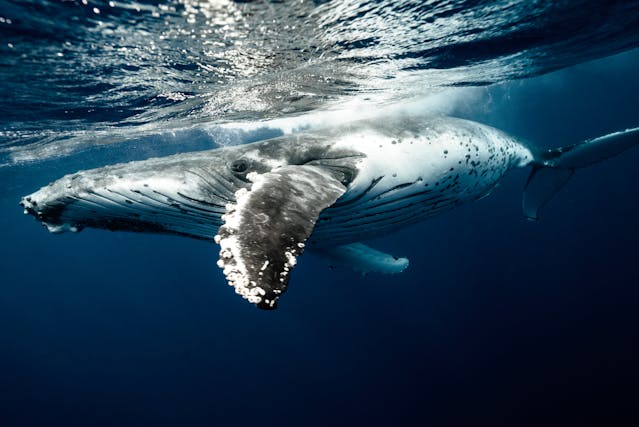
What is the loudest animal? The loudest animal in the world is the sperm whale. An adult sperm whale can produce clicks that are 230 decibels.
Sound is measured in decibels, which is a logarithmic system. A logarithmic system means that the next level is ten times higher than the previous level. So 20 dB is 10 times higher than 10 dB, not just plus ten. 10 dB is ten times higher than 1 dB and 20 dB is 100 times higher than 1 dB. Decibels are used to measure the pressure of sound, which is equal to its power and its intensity.
We are exposed to sound all day, and some of it can be so loud that it is dangerous. Breathing is 10 dB. A hairdryer is about 80 dB. An ambulance siren is 120 dB. Thunder is about 120 dB. A jet is about 150 dB. A rocket launching is 189 dB. Sounds at the higher end of this spectrum can actually be physically dangerous to us. They are dangerous not just to our ears, but to our whole bodies. That is because of the pressure. Sound is a wave of pressure moving through the air. The initial source of the sound releases energy and that energy gets transferred to the molecules, then onto the next molecules and so on. When the energy is transferred, it pushes all of the molecules together, increasing their pressure. You can feel that pressure wave if you are at a loud concert or if you watch an explosion. You can feel the sound when it hits you. If you get hit by a sound wave that is sufficiently high enough, it can destroy your ears, but it can also kill you as well. The pressure could collapse your lungs, disrupt your heart, and severely damage your organs. Sound needs to be over 200 dB for this to happen. Which, technically, means a sperm whale could kill you with sound.
Sperm whales make clicks that have been recorded at 230 dB. That is more than enough to kill a person. The click is very fast and takes about 100 microseconds, but it carries a huge amount of energy. Also, because they are underwater, the soundwave can travel so much farther. They make the click by using something called monkey lips, so called because they look like a monkey’s lips. Their entire heads are basically sound amplifiers. The sperm whale has two long nasal passages that run down either side of its head, past an organ called the spermaceti and an area of oil and fatty tissue that is called the junk. The nasal passage on one side is straight and runs straight to the whale’s blowhole, and the one on the other side is very twisty. There are pockets of air in all of the twists. The sperm whale pulls air down its blowhole, along the straight nasal tube, to the monkey lips, which snap together and make a click. The sound of the clip goes up the twisty nasal passage and is reflected off the air pockets. The click is funneled into the spermaceti organ and the oil filled junk, which amplifies the sound and directs it through an opening in the whale’s forehead. These powerful clicks can travel for several thousand kilometers through the water.
There is some argument that the blue whale might be the louder animal because it produces a loud sound for longer than the sperm whale does. The sperm whale’s sound only lasts a few microseconds, while the blue whale can produce a sound of 188 dB and sustain it for up to 30 seconds.
Animals in the sea have a slight advantage because their sound will travel much farther than animals on land. The loudest land animal is the greater bulldog bat, which lives in South and Central America. It can make a sound of 140 dB. They use sound to hunt, called echolocation, as most bats do. Their cry is very high-pitched and most of the time it is not so loud, but they can turn it up to a very loud sound. The difference in the volume is because they used high-pitched and relatively quiet sounds to hunt, and then they use very loud cries to communicate with other bats. They live in the noisy jungle and they need a lot of power to get their sounds through. This volume would damage our ears, but the greater bulldog bats have evolved to be able to deal with it. And this is what I learned today.
Sources
https://www.batcon.org/superlative-bats/
https://www.ifaw.org/journal/loudest-animals-on-earth
https://www.smithsonianmag.com/science-nature/the-sperm-whales-deadly-call-94653
https://www.usatoday.com/story/news/2022/09/25/loudest-animal-in-the-world/7895928001
https://en.wikipedia.org/wiki/Decibel
https://pulsarinstruments.com/news/understanding-decibels-decibel-scale-and-noise-measurement-units
https://science.howstuffworks.com/question124.htm
https://decibelpro.app/blog/can-sound-kill-you
https://noiseawareness.org/info-center/common-noise-levels
https://oceanographicmagazine.com/oceanviz/sperm-whale-sound-range
Photo by Elianne Dipp: https://www.pexels.com/photo/humpback-whale-underwater-4666750/
